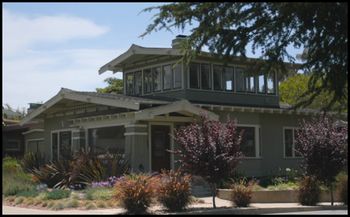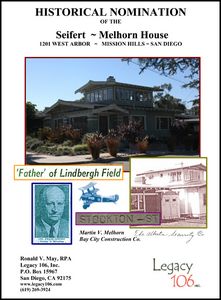|
|
 |
|
|
Historical Landmark No. 780 Mission Hills Community Historical Landmark No. 780 - Designated September 2006 |
|
|
| ||
|
|
The "Father of Lindbergh Field" This distinctive two story, front-gabled 1914 Airplane Craftsman bungalow is located in the North Florence Heights neighborhood of Mission Hills, San Diego. A product of the Arts and Crafts Movement, this house displays a striking blend of Oriental and Craftsman styles, with a second floor “airplane” observation room and multiple level Japonesque gabled peaks along varied rooflines that are reminiscent of temples in the Far East. Master Builder Martin V. Melhorn and his business partners John J. Wahrenberger and realtor John Rice formed Bay City Construction Company in 1911 and built this residence in the fall of 1914. Its location on a corner lot gives it presentation views on both the north and east elevations. Additionally, the two smaller houses that flank the house were also built by the same builders, and the three buildings together add prominence to the corner. The house is also important for its association with City Councilman Colonel Frank W. Seifert in 1928, when he achieved historical importance as the Father of Lindbergh Field. During his year residency at the house, Seifert distinguished himself as an important leader and historical person by getting the City Harbor Commission to dredge San Diego Bay and use the fill to create Lindbergh Field. Colonel Seifert further distinguished himself as the pilot of the first airplane to land at the new airfield, which is now San Diego’s famous international airport. All of this came together in 1928. The house is also significant because Master Builder Martin Van Melhorn designed and built it as a project of Bay City Construction Company. The high quality craftsmanship exhibited in this house compare favorably with that found at another Melhorn-built home, the 1913 Melhorn-King House at 1302 Washington Place, which is a City of San Diego Historic Landmark. Between 1911 and 1916, Melhorn worked with his partner craftsman carpenter John J. Wahrenberger to build Craftsman style houses that emphasized high quality carpentry cut work, such as is found in the Japonesque roofline and porch features in the Seifert-Melhorn House. The imposing corner setting and use of casement ribbon windows in the second floor observation room present an outstanding view from Jackdaw and W. Arbor. In fact, Melhorn built both houses on either side of the corner lot, in a compatible style. While those two houses are not part of this designation or study, they are part of the historical setting and architectural context of the neighborhood. Very few examples of Melhorn and Wahrenberger Bay City Construction Company Craftsman bungalows survive with this high level of integrity. In this period, Bay City Construction built nearly all of the nearby homes on Block 59 of Arnold & Choates subdivision, between Washington Street, Lark, Ingalls, and Fort Stockton Drive. Most of these homes are contemporaneous with the Seifert-Melhorn House, however, with the exception of the Melhorn-King house, which is also located on a corner lot, they have a high degree of integrity loss. As such, the Seifert-Melhorn House is important as a good surviving example from this era and as a representative work of the Bay City Construction Company and Master Builder Martin V. Melhorn. The Seiferts rented the house from the Chesley Trust for one year. City Councilman Frank W. Seifert achieved local historical significance in 1928 as “The Father of Lindbergh Field” While residing at the house, Councilman Seifert achieved another aviation milestone when he piloted the first airplane to land at Lindbergh Field on September 18, 1928. As a decorated United States Army pilot, he led an arduous political campaign to convince the City Council to build Lindbergh Field to draw commercial air traffic to San Diego. In his 1936 book, History of San Diego County, Carl Heilbron described Seifert as, “one of San Diego’s ablest business men and a progressive civic leader.” He and his wife, Bessie L. Seifert, lived at the house in 1928 at the time of his famous flight. Although he listed his occupation in the directory as an officer of the Expo-Stucco Products Company, he also served on the City of San Diego Council from 1927 to 1929. Frank was born in Ohio on September 29, 1896. Bessie was born December 13, 1897 in a foreign country. She lived in San Diego and died here on April 10, 1990. Her mother’s maiden name was McMahon and her father’s surname was Killeen. (California Death Index). The Articles of Incorporation for Expo-Stucco & Art Marble Company listed Seifert as a partner with Nolan R. Crooks and L.T. Olmstead. The incorporation date was August 11, 1927 (San Diego Historical Society, Box 54, File 1, #5135). Olmstead was Lester T. Olmstead, manager of the Brown-Olmstead Building Company. Seifert enlisted in the Army Air Corps in 1917 and was a World War I veteran. In 1923, First Lieutenant Seifert made aviation history on June 27, 1923 in a British de Haviland D.H.- 4B bi-plane as the first aviator to maneuver in-flight refueling operations (San Diego Union September 23, 1956). At the time, he was flying out of Rockwell Field in San Diego. He went on to establish new endurance records in aviation. As a City Councilman, Colonel Seifert organized and led the campaign to develop Lindbergh Field for national civilian aviation (San Diego Union April 18, 1960). He acquired the unofficial title “The Father of Lindbergh Field” and is given credit for coming up with the successful plan to dredge San Diego Bay to create fill for the airfield (San Diego Evening Tribune December 2, 1970). By 1930 they had moved to Hamilton Street and his younger brother Phillip lived with them (1930 U.S. Census). He mustered out in 1938 to work for Ryan Aeronautical from 1938 to 1940, but reenlisted in 1942 and flew combat missions against Japanese forced in the Pacific. After World War II ended, he served in Germany and saw duty with the Nuremberg War Crimes Commission. In 1956, the Air Force inducted him into the Aviation Hall of Fame for his accomplish-ments. He retired from the Air Force May 22, 1956 at age 60 as a full colonel (San Diego Union May 15, 1956). For his role in the development of in-flight refueling, he also received the Distinguished Flying Cross. In 1960, Seifert promoted the City Council and Harbor Commission to develop Brown Field as a second airfield, but the State Aeronautics Board opposed and scuttled the plan. By 1970, he advocated a new plan to shift all United States Navy air flights to North Island and transfer Miramar Naval Air Station to become the “San Diego Unified International Airport,” an idea that is still under consideration by the Airport Authority. He was among the founders of the San Diego Unified Port District and became City Manager for National City in 1952 and made an unsuccessful campaign for Congress. During the 1960s, he headed up the Grand Jury. He passed away on December 2, 1977 in San Diego (California Death Index). For his accomplishments during 1928 while he and his wife Bessie rented the house, he merits designation as a historical person associated with the house. | |
|
|
Information found about Bessie Seifert Researcher Leland Bibb contacted us after reading the history of the Seifert House. Intrigued by the fact that we had found little information about Bessie Seifert, Bibb decided to try and find out more about her and her family. Bibb learned that Bessie's parents, David and Minnie (Bourke) Killeen were living in Nebraska in 1900. Her father was born in New York and Mother in Missouri. He found the family in Elk Creek Township, Custer County, Nebraska, where they lived with their 7 children. Bessie was two years old at the time of the census, and that record shows she was born in Nebraska. In 1910, she and her family were still in Nebraska, but 3 of her siblings had moved out of the house. By 1920, Bessie was 22 years old and she and her folks had moved to San Diego to live on I Street. Her brother John and his new wife Eva lived just a few houses away. John listed his occupation on the 1920 U.S. Census as a league ball player. By 1930, her brother John and Eva were living in La Mesa where John was a building construction superintendent. Bibb's research illustrates how the hidden story of women's lives can be hard to track once they marry and their maiden name becomes obscured. In this case, the Killeen family was intertwined with the Seifert's in San Diego. This type of information is invaluable to historians, especially when trying to find descendants who might share family photographs and memories. Many thanks to Lee for his great investigative work! | |
|
|
Permission to use this material is granted provided it is attributed as follows: Copyright © 2010 Ronald V. May and Dale Ballou May, Legacy 106, Inc., www.legacy106.com | |
|
|
Home | Designations | Qualifications | Company Profile | Newsletter | Links Archaeology
& Historic Preservation www.legacy106.com |
|


